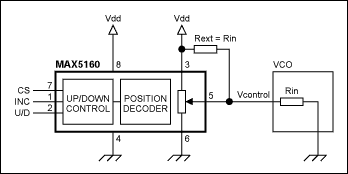
Digital potenTIometer ICs (digital pots, or digipots) are convenient for controlling voltage-controlled devices such as VCOs and as an economical alternative for a DAC. In a typical application (Figure 1), a MAX5160 digipot controls the frequency of a VCO, via a 3-wire interface.

Figure 1. Adding a resistor (Rext) to this VCO-control circuit minimizes nonlinearity while enhancing the mid-range frequency resolution.
The ideal relationship between wiper position and control voltage is a straight line (Figure 2). If the digipot's output resistance is high, however, the loading effect of the VCO input resistance (RIN) tends to make the relationship nonlinear and nonsymmetrical. See the "Without Rext" curve in Figure 2, for which RIN is 0.3 times the digipot's nominal output resistance.

Figure 2. These curves for wiper position vs. normalized control voltage in Figure 1 show the effect of adding a simple resistor (RIN) to the circuit.
Connecting a resistor (Rext) from VCONTROL to VDD reduces the loading effect of RIN. Making Rext = RIN brings the control curve closer to the ideal, and also makes it symmetrical with regard to the middle position. (See "With Rext" curve.) As an added bonus for VCO control, adding Rext = RIN provides finer resolution around the mid-range frequency, where control is usually the most critical.
欢迎分享,转载请注明来源:内存溢出

 微信扫一扫
微信扫一扫
 支付宝扫一扫
支付宝扫一扫
评论列表(0条)